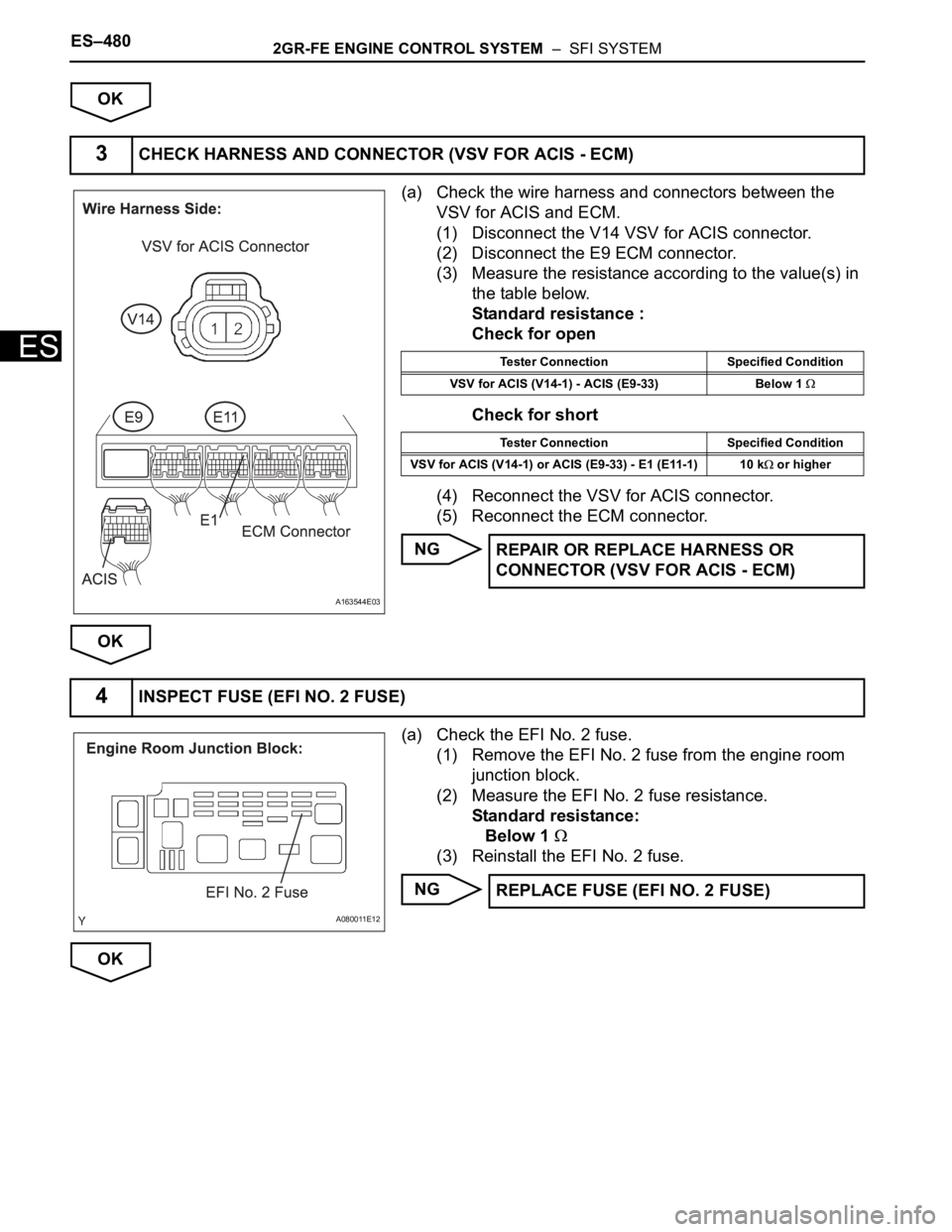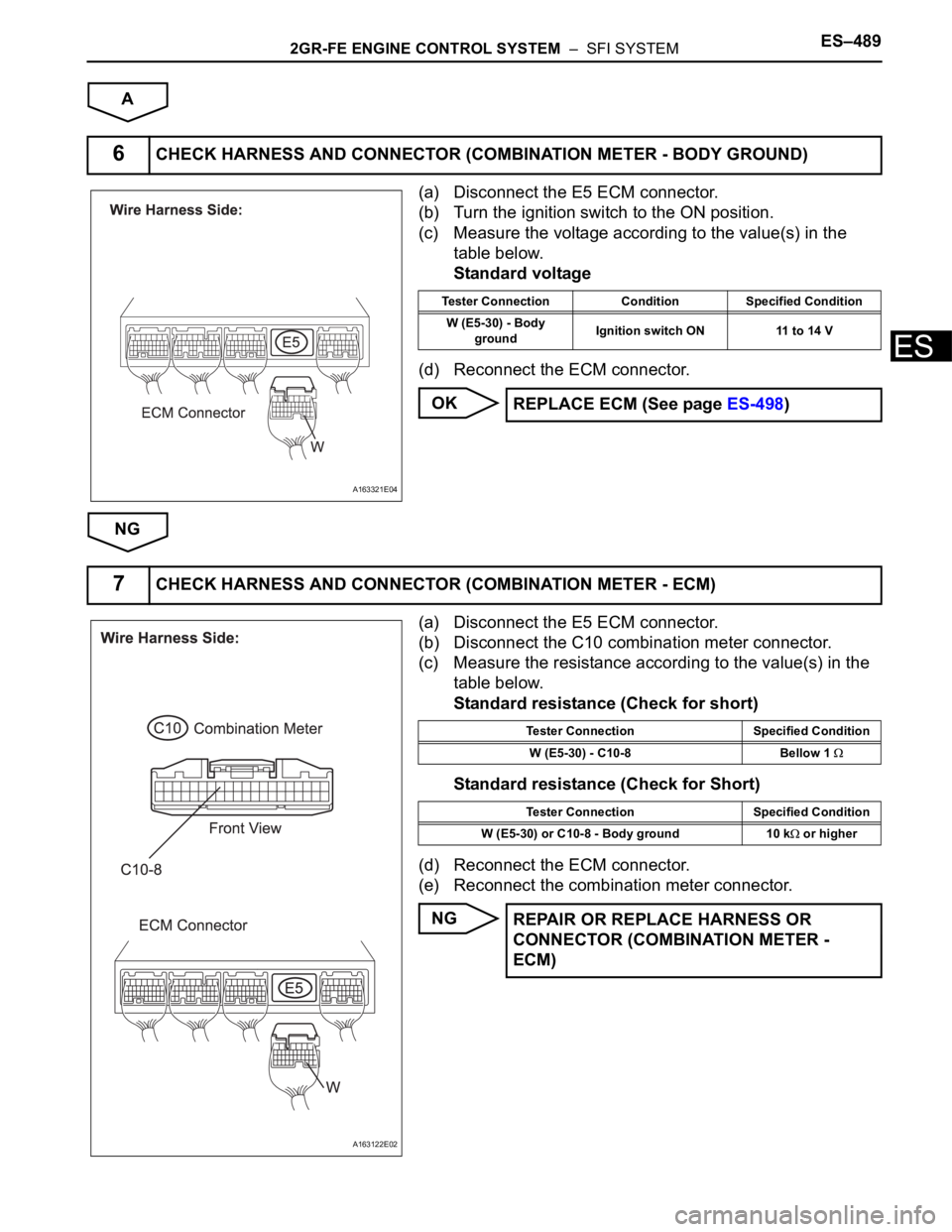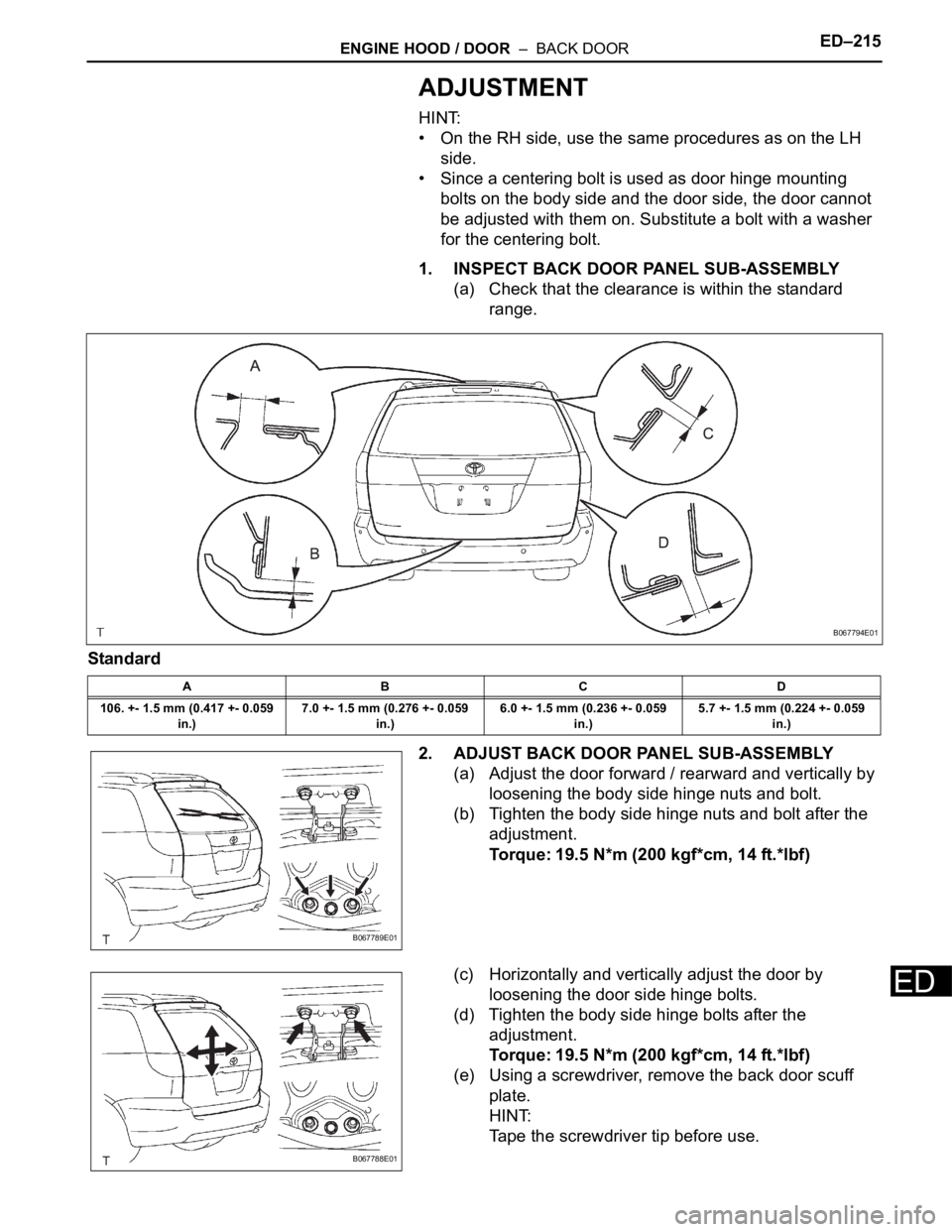Page 765 of 3000
2GR-FE ENGINE CONTROL SYSTEM – SFI SYSTEMES–479
ES
WIRING DIAGRAM
INSPECTION PROCEDURE
(a) Connect the intelligent tester to the DLC3.
(b) Start the engine and turn the intelligent tester on.
(c) Select the following menu items: DIAGNOSIS /
ENHANCED OBD II / ACTIVE TEST / INTAKE CTL
VSV1. Operate the VSV for AICS.
OK:
Operational noise can be heard.
OK
NG
(a) Disconnect the V14 VSV for ACIS connector.
(b) Apply battery voltage between the terminals of the air
intake valve connector.
(c) Check the air intake valve operation.
OK:
Operational noise can be heard.
(d) Reconnect the VSV for ACIS connector.
NG
1PERFORM ACTIVE TEST BY INTELLIGENT TESTER (OPERATE VSV FOR ACIS)
A136867E19
PROCEED TO NEXT CIRCUIT INSPECTION
SHOWN IN PROBLEM SYMPTOMS TABLE
2CHECK INTAKE AIR CONTROL VALVE (OPERATION)
E121181E09
REPLACE INTAKE AIR SURGE TANK
Page 766 of 3000

ES–4802GR-FE ENGINE CONTROL SYSTEM – SFI SYSTEM
ES
OK
(a) Check the wire harness and connectors between the
VSV for ACIS and ECM.
(1) Disconnect the V14 VSV for ACIS connector.
(2) Disconnect the E9 ECM connector.
(3) Measure the resistance according to the value(s) in
the table below.
Standard resistance :
Check for open
Check for short
(4) Reconnect the VSV for ACIS connector.
(5) Reconnect the ECM connector.
NG
OK
(a) Check the EFI No. 2 fuse.
(1) Remove the EFI No. 2 fuse from the engine room
junction block.
(2) Measure the EFI No. 2 fuse resistance.
Standard resistance:
Below 1
(3) Reinstall the EFI No. 2 fuse.
NG
OK
3CHECK HARNESS AND CONNECTOR (VSV FOR ACIS - ECM)
A163544E03
Tester Connection Specified Condition
VSV for ACIS (V14-1) - ACIS (E9-33) Below 1
Tester Connection Specified Condition
VSV for ACIS (V14-1) or ACIS (E9-33) - E1 (E11-1) 10 k
or higher
REPAIR OR REPLACE HARNESS OR
CONNECTOR (VSV FOR ACIS - ECM)
4INSPECT FUSE (EFI NO. 2 FUSE)
A080011E12
REPLACE FUSE (EFI NO. 2 FUSE)
Page 767 of 3000
2GR-FE ENGINE CONTROL SYSTEM – SFI SYSTEMES–481
ES
(a) Check the wire harness between the VSV for ACIS
connector and EFI relay.
(1) Remove the EFI relay from the engine room junction
block.
(2) Disconnect the V14 VSV connector.
(3) Measure the resistance according to the value(s) in
the table below.
Standard resistance :
Check for open
(4) Reinstall the EFI relay.
(5) Reconnect the VSV connector.
NG
OK
5CHECK HARNESS AND CONNECTOR (VSV FOR ACIS - EFI RELAY)
A163545E04
Tester Connection Specified Condition
VSV for ACIS (V14-2) - EFI relay terminal (3) Below 1
REPAIR OR REPLACE HARNESS OR
CONNECTOR (VSV FOR ACIS - EFI RELAY)
CHECK ECM POWER SOURCE CIRCUIT (See page ES-437)
Page 768 of 3000

ES–4862GR-FE ENGINE CONTROL SYSTEM – SFI SYSTEM
ES
DESCRIPTION
The MIL (Malfunction Indicator Lamp) is used to indicate vehicle malfunctions detected by the ECM.
When the ignition switch is turned to the ON position, power is supplied to the MIL circuit, and the ECM
provides the circuit ground which illuminates the MIL.
The MIL operation can be checked visually. When the ignition switch is first turned to the ON position, the
MIL should be illuminated and should then turn off. If the MIL remains illuminated or is not illuminated,
conduct the following troubleshooting procedure using the intelligent tester.
WIRING DIAGRAM
INSPECTION PROCEDURE
(a) Turn the ignition switch to the ON position.
(b) Check the illumination of the MIL.
Result
MIL Circuit
1CHECK THAT MIL IS ILLUMINATED
A136868E04
Result Proceed to
MIL remains illuminated (Even after ignition switch is turned to ON position and several
seconds have passed, MIL still remains illuminated)A
MIL remains off (Does not illuminate at all)B
MIL illuminates for several seconds, but turns off after engine is started C
Page 769 of 3000
2GR-FE ENGINE CONTROL SYSTEM – SFI SYSTEMES–487
ES
B
C
A
(a) Connect the intelligent tester to the DLC3.
(b) Turn the ignition switch to the ON position and turn the
tester on.
(c) Select the following menu items: DIAGNOSIS /
ENHANCED OBD II / DTC INFO / CURRENT CODES.
(d) Check if any DTCs have been stored. Note down any
DTCs.
(e) Clear the DTCs (See page ES-39).
(f) Check if the MIL goes off.
Standard:
MIL goes off.
OK
NG
(a) Disconnect the E5 ECM connector.
(b) Turn the ignition switch to the ON position.
(c) Check that the MIL is not illuminated.
OK:
MIL is not illuminated.
(d) Reconnect the ECM connector.
OK
NG Go to step 5
SYSTEM OK
2CHECK WHETHER MIL TURNS OFF
REPAIR CIRCUITS INDICATED BY OUTPUT
DTCS
3CHECK HARNESS AND CONNECTOR (CHECK FOR SHORT IN WIRE HARNESS)
A163321E03
REPLACE ECM (See page ES-498)
Page 770 of 3000
ES–4882GR-FE ENGINE CONTROL SYSTEM – SFI SYSTEM
ES
(a) Disconnect the E5 ECM connector.
(b) Disconnect the C10 combination meter connector.
(c) Measure the resistance according to the value(s) in the
table below.
Standard resistance (Check for Open)
Standard resistance (Check for Short)
(d) Reconnect the ECM connector.
(e) Reconnect the combination meter connector.
OK
NG
(a) Turn the ignition switch to the ON position.
(b) Start the engine.
Result
HINT:
*: The intelligent tester cannot communicate with the
ECM.
B
4CHECK HARNESS AND CONNECTOR (COMBINATION METER - ECM)
A163122E02
Tester Connection Specified Condition
W (E5-30) - C10-8 Bellow 1
Tester Connection Specified Condition
W (E5-30) or C10-8 - Body ground 10 k
or higher
REPLACE COMBINATION METER
ASSEMBLY
REPAIR OR REPLACE HARNESS OR CONNECTOR (COMBINATION METER - ECM)
5CHECK THAT ENGINE STARTS
Result Proceed to
Engine starts A
Engine does not start* B
GO TO VC OUTPUT CIRCUIT (See page ES-
444)
Page 771 of 3000

2GR-FE ENGINE CONTROL SYSTEM – SFI SYSTEMES–489
ES
A
(a) Disconnect the E5 ECM connector.
(b) Turn the ignition switch to the ON position.
(c) Measure the voltage according to the value(s) in the
table below.
Standard voltage
(d) Reconnect the ECM connector.
OK
NG
(a) Disconnect the E5 ECM connector.
(b) Disconnect the C10 combination meter connector.
(c) Measure the resistance according to the value(s) in the
table below.
Standard resistance (Check for short)
Standard resistance (Check for Short)
(d) Reconnect the ECM connector.
(e) Reconnect the combination meter connector.
NG
6CHECK HARNESS AND CONNECTOR (COMBINATION METER - BODY GROUND)
A163321E04
Tester Connection Condition Specified Condition
W (E5-30) - Body
groundIgnition switch ON 11 to 14 V
REPLACE ECM (See page ES-498)
7CHECK HARNESS AND CONNECTOR (COMBINATION METER - ECM)
A163122E02
Tester Connection Specified Condition
W (E5-30) - C10-8 Bellow 1
Tester Connection Specified Condition
W (E5-30) or C10-8 - Body ground 10 k
or higher
REPAIR OR REPLACE HARNESS OR
CONNECTOR (COMBINATION METER -
ECM)
Page 774 of 3000

ENGINE HOOD / DOOR – BACK DOORED–215
ED
ADJUSTMENT
HINT:
• On the RH side, use the same procedures as on the LH
side.
• Since a centering bolt is used as door hinge mounting
bolts on the body side and the door side, the door cannot
be adjusted with them on. Substitute a bolt with a washer
for the centering bolt.
1. INSPECT BACK DOOR PANEL SUB-ASSEMBLY
(a) Check that the clearance is within the standard
range.
Standard
2. ADJUST BACK DOOR PANEL SUB-ASSEMBLY
(a) Adjust the door forward / rearward and vertically by
loosening the body side hinge nuts and bolt.
(b) Tighten the body side hinge nuts and bolt after the
adjustment.
Torque: 19.5 N*m (200 kgf*cm, 14 ft.*lbf)
(c) Horizontally and vertically adjust the door by
loosening the door side hinge bolts.
(d) Tighten the body side hinge bolts after the
adjustment.
Torque: 19.5 N*m (200 kgf*cm, 14 ft.*lbf)
(e) Using a screwdriver, remove the back door scuff
plate.
HINT:
Tape the screwdriver tip before use.
ABCD
106. +- 1.5 mm (0.417 +- 0.059
in.)7.0 +- 1.5 mm (0.276 +- 0.059
in.)6.0 +- 1.5 mm (0.236 +- 0.059
in.)5.7 +- 1.5 mm (0.224 +- 0.059
in.)
B067794E01
B067789E01
B067788E01